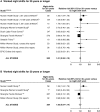Night Shift Work and Breast Cancer Incidence: Three Prospective Studies and Meta-analysis of Published Studies
- PMID: 27758828
- PMCID: PMC5241898
- DOI: 10.1093/jnci/djw169
Night Shift Work and Breast Cancer Incidence: Three Prospective Studies and Meta-analysis of Published Studies
Abstract
Background: It has been proposed that night shift work could increase breast cancer incidence. A 2007 World Health Organization review concluded, mainly from animal evidence, that shift work involving circadian disruption is probably carcinogenic to humans. We therefore aimed to generate prospective epidemiological evidence on night shift work and breast cancer incidence.
Methods: Overall, 522 246 Million Women Study, 22 559 EPIC-Oxford, and 251 045 UK Biobank participants answered questions on shift work and were followed for incident cancer. Cox regression yielded multivariable-adjusted breast cancer incidence rate ratios (RRs) and 95% confidence intervals (CIs) for night shift work vs no night shift work, and likelihood ratio tests for interaction were used to assess heterogeneity. Our meta-analyses combined these and relative risks from the seven previously published prospective studies (1.4 million women in total), using inverse-variance weighted averages of the study-specific log RRs.
Results: In the Million Women Study, EPIC-Oxford, and UK Biobank, respectively, 673, 28, and 67 women who reported night shift work developed breast cancer, and the RRs for any vs no night shift work were 1.00 (95% CI = 0.92 to 1.08), 1.07 (95% CI = 0.71 to 1.62), and 0.78 (95% CI = 0.61 to 1.00). In the Million Women Study, the RR for 20 or more years of night shift work was 1.00 (95% CI = 0.81 to 1.23), with no statistically significant heterogeneity by sleep patterns or breast cancer risk factors. Our meta-analysis of all 10 prospective studies included 4660 breast cancers in women reporting night shift work; compared with other women, the combined relative risks were 0.99 (95% CI = 0.95 to 1.03) for any night shift work, 1.01 (95% CI = 0.93 to 1.10) for 20 or more years of night shift work, and 1.00 (95% CI = 0.87 to 1.14) for 30 or more years.
Conclusions: The totality of the prospective evidence shows that night shift work, including long-term shift work, has little or no effect on breast cancer incidence.
© The Author 2016. Published by Oxford University Press. All rights reserved. For Permissions, please e-mail: journals.permissions@oup.com.
Figures



Comment in
-
RE: Night Shift Work and Breast Cancer Incidence: Three Prospective Studies and Meta-analysis of Published Studies.J Natl Cancer Inst. 2017 Apr 1;109(4). doi: 10.1093/jnci/djw342. J Natl Cancer Inst. 2017. PMID: 28376168 No abstract available.
-
RE: Night Shiftwork and Breast Cancer Incidence: Three Prospective Studies and Meta-analysis of Published Studies.J Natl Cancer Inst. 2017 Apr 1;109(4). doi: 10.1093/jnci/djw343. J Natl Cancer Inst. 2017. PMID: 28376169 No abstract available.
-
RE: Night Shift Work and Breast Cancer Incidence: Three Prospective Studies and Meta-analysis of Published Studies.J Natl Cancer Inst. 2017 Apr 1;109(4). doi: 10.1093/jnci/djw344. J Natl Cancer Inst. 2017. PMID: 28376170 No abstract available.
-
RE: Night Shift Work and Breast Cancer Incidence: Three Prospective Studies and Meta-analysis of Published Studies.J Natl Cancer Inst. 2017 Apr 1;109(4). doi: 10.1093/jnci/djx002. J Natl Cancer Inst. 2017. PMID: 28376171 No abstract available.
-
Response.J Natl Cancer Inst. 2017 Apr 1;109(4). doi: 10.1093/jnci/djx008. J Natl Cancer Inst. 2017. PMID: 28376172 No abstract available.
References
-
- Stevens RG, Davis S, Thomas DB, Anderson LE, Wilson BW. Electric power, pineal function, and the risk of breast cancer. Faseb J. 1992;6(3):853–860. - PubMed
-
- Straif K, Baan R, Grosse Y, et al. Carcinogenicity of shift-work, painting, and fire-fighting. Lancet Oncol. 2007;8 (12):1065–1066. - PubMed
-
- Pirie K, Beral V, Peto R, et al. Passive smoking and breast cancer in never smokers: prospective study and meta-analysis. Int J Epidemiol. 2008;37 (5):1069–1079. - PubMed
-
- Collaborative Group on Hormonal Factors in Breast Cancer. Breast cancer and abortion: collaborative reanalysis of data from 53 epidemiological studies, including 83 000 women with breast cancer from 16 countries. Lancet. 2004;363 (9414):1007–1016. - PubMed
Publication types
MeSH terms
Grants and funding
LinkOut - more resources
Full Text Sources
Other Literature Sources
Medical

